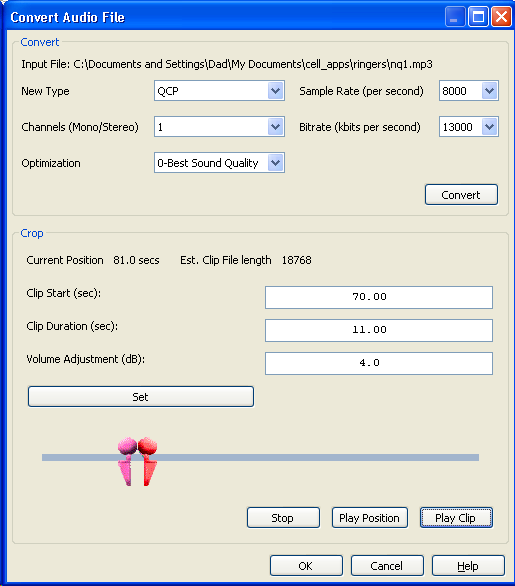
This converter results in file sizes significantly larger than MIDI ringtones. Be very careful with file sizes. We have no way of knowing how much free space is on the phone file, and the phone may become inoperable if it runs out of space. (They usually at least hang and have to be rebooted.)

This dialog helps you convert an audio item into a format that the phone will understand such as MP3 or QCP. Select the conversion criteria in the top half and hit the convert button. The conversion process will take quite a long time, possibly up to a minute. There will be an hourglass cursor during the conversion.
After the conversion has completed, you will want to select which portion is actually used. Use the two sliders to change the beginning and end. You can press Play Clip to hear the selected portion in its entirety, or Play Position to play from the position marker. The text fields update to tell you how long the clip is in both time and file size.
Finally press Ok to save the clip. This may also take some time as just the selected portion needs to be extracted and appropriately encoded.
These are the parameters that control the conversion:
Channels
This controls if the ouput is mono or stereo. It is extremely unlikely that your phone does stereo, or even if it did that you would be able to tell the difference.
Sample Rate
The is how many slices each second is chopped into. While having as many as possible is better, there is a limit. The speaker in your phone won't go very high as it is optimised for speech, which can typically be represented in less than 8000 cycles per second. Human hearing is limited to 20,000 cycles per second and decreases as you get older. Each cycle is single wave of sound.
If you are an audiophile, you'll want double the number of samples as there are cycles, which is why CDs use 44,100. You'll also not want to confuse a cell phone ringtone with CDs, a good amplifier and speaker setup!
Bitrate (kbits/second)
This is how many thousand bits of data are used per second to represent the sound. This is done by approximating the sound information with the coarseness of the approximation based on the the bitrate and the sample rate. (The more samples you have, the fewer bits are available to represent each one.) The bitrate is what accounts for the resulting file size.
Optimization (QCP Only)
This defines the level of optimization in converting to QCP files. The conversion can be optimized for audio quality with larger file size, or smaller file size with less audio quality.
Clip Start
The start of the clip specified as an offset (in seconds) from the beginning of the sound file.
Clip Duration
The size (how long) of the clip in seconds.
Volume Adjustment
Changes to the volume of the clip in decibels (dB). 0 dB specifies no changes, positive dB specifies louder volume, negative dB less loud.
Set
Click on this to apply the values of the Crop Fields.
Play Clip
Play the current clip which parameters are specified by the Crop Fields.
Play Position
Play the sound file from the current position to the end of the file.
Stop
Stop playing
Be very careful with file sizes. We have no way of knowing how much free space is on the phone file, and the phone may become inoperable if it runs out of space. (They usually at least hang and have to be rebooted.)
You are recommended to keep the size below 64kb (65,536 bytes)
(Note: QCP doesn't have any choices for sample rate.) You should use the lower sample rates. The phone may not even play the higher rates since it requires altering speaker levels more times per second.
You are recommended to use 16,000 or 22,050 as the sample rate.
(Note: QCP doesn't have any choices for bitrate.) You should use the lower bitrates. The phone may not even play the higher rates since it requires processing more data per second. Lower bitrates also result in smaller file sizes.
You are recommended to use 32 kbits per second.
There is no point having the length longer than 30 seconds since the call will go to voicemail before then. The phone will loop shorter clips.
A 16 second clip at 32 kbits/second will result in a file size of 64kb.
BitPim Online Help built 17 January 2010